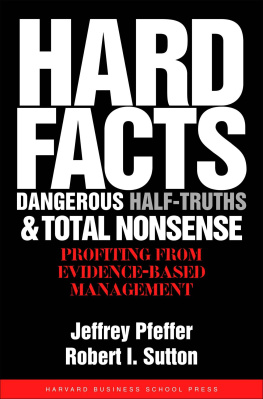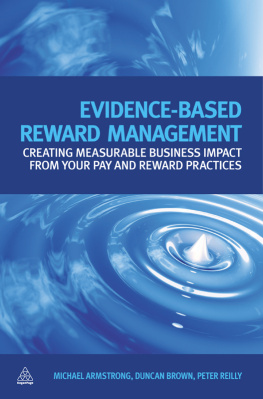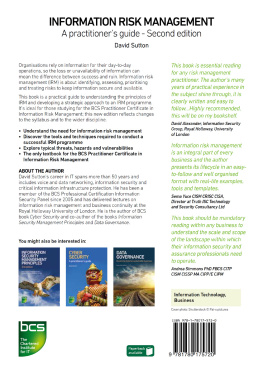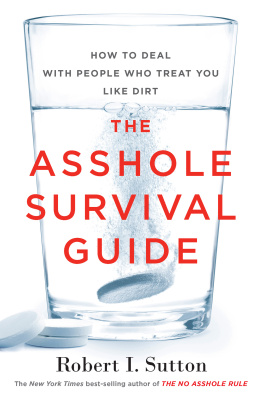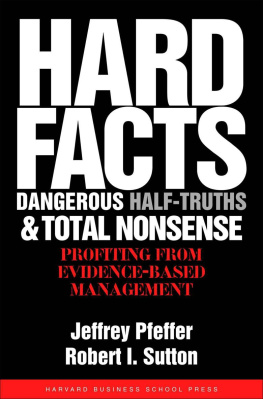Sutton Robert I. - Hard Facts, Dangerous Half-Truths, and Total Nonsense · Profiting from Evidence-based Management
Here you can read online Sutton Robert I. - Hard Facts, Dangerous Half-Truths, and Total Nonsense · Profiting from Evidence-based Management full text of the book (entire story) in english for free. Download pdf and epub, get meaning, cover and reviews about this ebook. year: 2006, publisher: Harvard Business Review Press, genre: Business. Description of the work, (preface) as well as reviews are available. Best literature library LitArk.com created for fans of good reading and offers a wide selection of genres:
Romance novel
Science fiction
Adventure
Detective
Science
History
Home and family
Prose
Art
Politics
Computer
Non-fiction
Religion
Business
Children
Humor
Choose a favorite category and find really read worthwhile books. Enjoy immersion in the world of imagination, feel the emotions of the characters or learn something new for yourself, make an fascinating discovery.
- Book:Hard Facts, Dangerous Half-Truths, and Total Nonsense · Profiting from Evidence-based Management
- Author:
- Publisher:Harvard Business Review Press
- Genre:
- Year:2006
- Rating:3 / 5
- Favourites:Add to favourites
- Your mark:
- 60
- 1
- 2
- 3
- 4
- 5
Hard Facts, Dangerous Half-Truths, and Total Nonsense · Profiting from Evidence-based Management: summary, description and annotation
We offer to read an annotation, description, summary or preface (depends on what the author of the book "Hard Facts, Dangerous Half-Truths, and Total Nonsense · Profiting from Evidence-based Management" wrote himself). If you haven't found the necessary information about the book — write in the comments, we will try to find it.
Sutton Robert I.: author's other books
Who wrote Hard Facts, Dangerous Half-Truths, and Total Nonsense · Profiting from Evidence-based Management? Find out the surname, the name of the author of the book and a list of all author's works by series.
Hard Facts, Dangerous Half-Truths, and Total Nonsense · Profiting from Evidence-based Management — read online for free the complete book (whole text) full work
Below is the text of the book, divided by pages. System saving the place of the last page read, allows you to conveniently read the book "Hard Facts, Dangerous Half-Truths, and Total Nonsense · Profiting from Evidence-based Management" online for free, without having to search again every time where you left off. Put a bookmark, and you can go to the page where you finished reading at any time.
Font size:
Interval:
Bookmark:

Hard Facts, Dangerous Half-Truths, and Total Nonsense delivers a clear and compelling approach to management and leading successful organizations. A great gift to leaders determined to be viable, relevant, and effective in a tenuous future.
Frances Hesselbein, Chairman, Leader to Leader Institute
Pfeffer and Sutton marshal bountiful evidence to demolish a number of the most cherished and ingrained superstitions in all of management. And even better, they provide a suite of practical tools for profiting from evidence-based management. If you want to unlock the secrets to outperforming your superstitious competitors, this book is your key.
Roger Martin, Dean, Rotman School of Management,
University of Toronto, and former Global Co-head of
Monitor Company
Virtually every organization, public or private, lives or dies on the bottom line of execution. The powerful insights of Hard Facts, Dangerous Half-Truths, and Total Nonsense point out that the road to profitability and better execution is all too often littered with more myth than evidence. To understand these perspectives is to turn roadblocks into building blocks.
Rudy Crew, Superintendent, Miami-Dade County Public Schools, Former Chancellor, New York City Department of Education
Copyright 2006 Jeffrey Pfeffer and Robert I. Sutton
All rights reserved
Printed in the United States of America
10 09 08 07 06 5 4 3 2 1
No part of this publication may be reproduced, stored in or introduced into a retrieval system, or transmitted, in any form, or by any means (electronic, mechanical, photocopying, recording, or otherwise), without the prior permission of the publisher. Requests for permission should be directed to permissions@hbsp . harvard.edu , or mailed to Permissions, Harvard Business School Publishing, 60 Harvard Way, Boston, Massachusetts 02163.
Library of Congress Cataloging-in-Publication Data
Pfeffer, Jeffrey.
Hard facts, dangerous half-truths, and total nonsense : profiting from evidence-based management / Jeffrey Pfeffer, Robert I. Sutton.
p. cm.
Includes bibliographical references.
9781422154588
1. Industrial managementDecision making. I. Sutton, Robert I. II. Title.
HD30.23.P468 2006
658.403dc22
2005030854
The paper used in this publication meets the minimum requirements of the American National Standard for Information SciencesPermanence of Paper for Printed Library Materials, ANSI Z39.48-1992.
To Kathleen and Marina,
The Loves of Our Lives
Our last book, The Knowing-Doing Gap , struck a chord with lots of people. In many companies there were experienced, intelligent, motivated people who, both individually and collectively, knew what to do but couldnt or wouldnt act on that knowledge. We identified the main causes of knowing-doing gaps and how organizations could avoid or reverse such impediments to action. We also found that the problem was not confined to for-profit companies. We heard story after story from people in educational research and school administration about how decades of research on teaching and learning was neglected in the practices actually enacted in schools. As we write this preface in the fall of 2005, we see the problem playing out once again. The terrible devastation and human suffering caused by hurricane Katrina, which nearly obliterated New Orleans and much of the nearby Gulf Coast, and the halting, disorganized initial rescue efforts reflect the failure to implement what was known and even planned for months and years ago both to mitigate the effects of the storm and to speed up recovery efforts. There is no question that the knowing-doing gap persists as a big problem in the private and public sector.
After writing The Knowing-Doing Gap we soon encountered a different and somewhat unexpected management problem. People kept telling us about the wonderful things they were doing to implement knowledgebut those things often clashed with, and at times were the opposite of, what we knew about organizations and people. Upon probing, we soon discovered that many managers had been prompted by a seminar, book, or consultants to do things that were at odds with the best evidence about what works. We began to call this the doing-knowing problemdoing without knowing, or at least knowing enough.
We became fascinated with why this problem existed, and what might be done about it. We also became fascinated with certain half-truths that we kept hearing again and again, ideas and principles that are partly right at times, but are flawed and misleading often enough to get organizations into serious trouble. Beliefs like the best organizations have the best people, strategy is destiny, and great leaders are in control and ought to be have an element of truth, but when treated as the whole truth and applied to every decision and design of every program and practice, they cause severe damage to companies; management careers; and employee loyalty, effort, and mental health. Meanwhile, we witnessed attempts to introduce evidence-based practice into education, efforts thatdespite the best intentionswere often met with resistance that undermined learning and wasted billions of dollars. We also followed the rise in evidence-based medicine because a number of our former students are physicians with a heavy research emphasis in their practice and work. We began to wonder if there were principles that might apply across domains and make decisions and actions wiser. In fact, in the National Institute of Healths publication Keeping Patients Safe , there is a chapter entitled Evidence-Based Management.
So off we went, to study organizations, read, think, and to the surprise of no one who knows us, to argue and debate about the best logic, evidence, and management practices. The result is this book. It is a call for evidence-based management, a case for its potential impact, and a guide on how to use it. Hard Facts, Dangerous Half-Truths, and Total Nonsense identifies some of the barriers to implementing evidence-based management and presents steps that leaders can take to overcome those barriers, with an emphasis on how to manage in light of the most dangerous half-truths that bedevil organizations.
We emerged from this exercise with a renewed appreciation for how difficult it is to manage and lead an organization, and how much time and effort managers must devote to learning their craft. We also gained a stronger appreciation for how evidence-based management can help managers and leaders do a better job of learning and practicing their profession, and make these difficult jobs a bit less taxing and more successful. There are no simple, easy answers, but there are answers: better ways of thinking about business knowledge and more fact-based ways of understanding management practices. This book shares our insights and the results of our research, thought, reading, and yes, argument and debate, with you.
O N THE DAY Synoptics and Wellfleet Communications merged to form Bay Networks, the companys revenue was about equal to its major competitor, Cisco Systems. If you havent heard of Bay Networks, dont be surprised. This merger between two firms, similar in size and headquartered on opposite coasts of the United States, failed by any measure. Bay Networks fell on hard times economically, was left in the dust technologically by Cisco and others, and was finally purchased by Nortelanother troubled networking company that suffered operating problems as a result of botched mergers. Mergers often come to a bad end. Remember Consecothe insurance and financial services company that purchased Green Tree Lending, a company that financed the purchase of mobile homes by non-prime borrowers? Conseco wound up in bankruptcy and CEO Stephen Hilbert was fired. Or how about Mattel, the famous toy company? In an attempt to diversify beyond its Barbie franchise, Mattel made an ill-fated acquisition of the Learning Company, a technology-based education firm. The deal cost Mattel a lot of money, led to a substantial decline in its stock market value, and effectively ended the corporate career of CEO Jill Barad. And remember the ill-fated Daimler-Chrysler, American OnlineTime Warner, and Hewlett-PackardCompaq mergers?
Font size:
Interval:
Bookmark:
Similar books «Hard Facts, Dangerous Half-Truths, and Total Nonsense · Profiting from Evidence-based Management»
Look at similar books to Hard Facts, Dangerous Half-Truths, and Total Nonsense · Profiting from Evidence-based Management. We have selected literature similar in name and meaning in the hope of providing readers with more options to find new, interesting, not yet read works.
Discussion, reviews of the book Hard Facts, Dangerous Half-Truths, and Total Nonsense · Profiting from Evidence-based Management and just readers' own opinions. Leave your comments, write what you think about the work, its meaning or the main characters. Specify what exactly you liked and what you didn't like, and why you think so.

